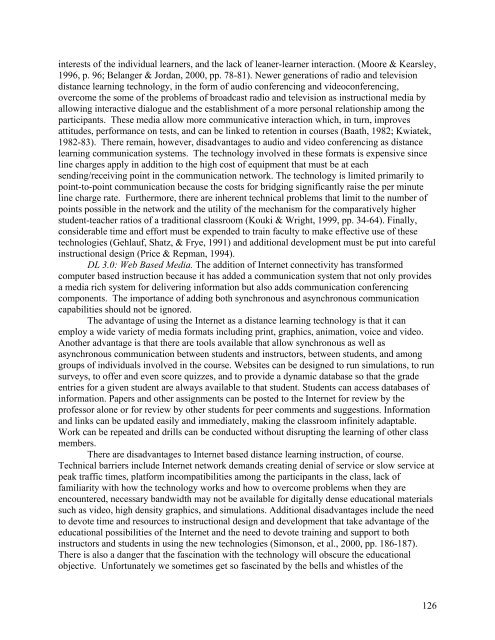2008 PROCEEDINGS - Public Relations Society of America
2008 PROCEEDINGS - Public Relations Society of America
2008 PROCEEDINGS - Public Relations Society of America
You also want an ePaper? Increase the reach of your titles
YUMPU automatically turns print PDFs into web optimized ePapers that Google loves.
interests <strong>of</strong> the individual learners, and the lack <strong>of</strong> leaner-learner interaction. (Moore & Kearsley,<br />
1996, p. 96; Belanger & Jordan, 2000, pp. 78-81). Newer generations <strong>of</strong> radio and television<br />
distance learning technology, in the form <strong>of</strong> audio conferencing and videoconferencing,<br />
overcome the some <strong>of</strong> the problems <strong>of</strong> broadcast radio and television as instructional media by<br />
allowing interactive dialogue and the establishment <strong>of</strong> a more personal relationship among the<br />
participants. These media allow more communicative interaction which, in turn, improves<br />
attitudes, performance on tests, and can be linked to retention in courses (Baath, 1982; Kwiatek,<br />
1982-83). There remain, however, disadvantages to audio and video conferencing as distance<br />
learning communication systems. The technology involved in these formats is expensive since<br />
line charges apply in addition to the high cost <strong>of</strong> equipment that must be at each<br />
sending/receiving point in the communication network. The technology is limited primarily to<br />
point-to-point communication because the costs for bridging significantly raise the per minute<br />
line charge rate. Furthermore, there are inherent technical problems that limit to the number <strong>of</strong><br />
points possible in the network and the utility <strong>of</strong> the mechanism for the comparatively higher<br />
student-teacher ratios <strong>of</strong> a traditional classroom (Kouki & Wright, 1999, pp. 34-64). Finally,<br />
considerable time and effort must be expended to train faculty to make effective use <strong>of</strong> these<br />
technologies (Gehlauf, Shatz, & Frye, 1991) and additional development must be put into careful<br />
instructional design (Price & Repman, 1994).<br />
DL 3.0: Web Based Media. The addition <strong>of</strong> Internet connectivity has transformed<br />
computer based instruction because it has added a communication system that not only provides<br />
a media rich system for delivering information but also adds communication conferencing<br />
components. The importance <strong>of</strong> adding both synchronous and asynchronous communication<br />
capabilities should not be ignored.<br />
The advantage <strong>of</strong> using the Internet as a distance learning technology is that it can<br />
employ a wide variety <strong>of</strong> media formats including print, graphics, animation, voice and video.<br />
Another advantage is that there are tools available that allow synchronous as well as<br />
asynchronous communication between students and instructors, between students, and among<br />
groups <strong>of</strong> individuals involved in the course. Websites can be designed to run simulations, to run<br />
surveys, to <strong>of</strong>fer and even score quizzes, and to provide a dynamic database so that the grade<br />
entries for a given student are always available to that student. Students can access databases <strong>of</strong><br />
information. Papers and other assignments can be posted to the Internet for review by the<br />
pr<strong>of</strong>essor alone or for review by other students for peer comments and suggestions. Information<br />
and links can be updated easily and immediately, making the classroom infinitely adaptable.<br />
Work can be repeated and drills can be conducted without disrupting the learning <strong>of</strong> other class<br />
members.<br />
There are disadvantages to Internet based distance learning instruction, <strong>of</strong> course.<br />
Technical barriers include Internet network demands creating denial <strong>of</strong> service or slow service at<br />
peak traffic times, platform incompatibilities among the participants in the class, lack <strong>of</strong><br />
familiarity with how the technology works and how to overcome problems when they are<br />
encountered, necessary bandwidth may not be available for digitally dense educational materials<br />
such as video, high density graphics, and simulations. Additional disadvantages include the need<br />
to devote time and resources to instructional design and development that take advantage <strong>of</strong> the<br />
educational possibilities <strong>of</strong> the Internet and the need to devote training and support to both<br />
instructors and students in using the new technologies (Simonson, et al., 2000, pp. 186-187).<br />
There is also a danger that the fascination with the technology will obscure the educational<br />
objective. Unfortunately we sometimes get so fascinated by the bells and whistles <strong>of</strong> the<br />
126
















